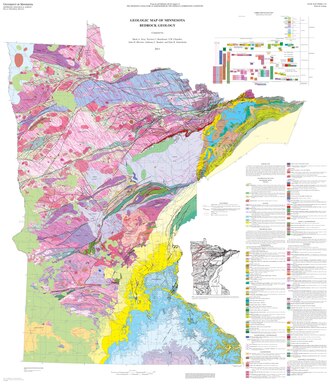
The geology of Minnesota comprises the rock, minerals, and soils of the U.S. state of Minnesota, including their formation, development, distribution, and condition.
The state's geologic history can be divided into three periods. The first period was a lengthy period of geologic instability from the origin of the planet until roughly 1,100 million years ago. During this time, the state's Precambrian bedrock was formed by volcanism and the deposition of sedimentary rock and then modified by processes such as faulting, folding and erosion. In the second period, many layers of sedimentary rock were formed by deposition and lithification of successive layers of sediment from runoff and repeated incursions of the sea. In the third and most recent period starting about 1.8 million years ago, glaciation eroded previous rock formations and deposited deep layers of glacial till over most of the state, and created the beds and valleys of modern lakes and rivers.
Minnesota's geologic resources have been the historical foundation of the state's economy. Precambrian bedrock has been mined for metallic minerals, including iron ore, on which the economy of Northeast Minnesota was built. Archaen granites and gneisses, and later limestones and sandstones, are quarried for structural stone and monuments. Glacial deposits are mined for aggregates, glacial till and lacustrine deposits formed the parent soil for the state's farmlands, and glacial lakes are the backbone of Minnesota's tourist industry. These economic assets have in turn dictated the state's history and settlement patterns, and the trade and supply routes along the waterways, valleys and plains have become the state's transportation corridors.